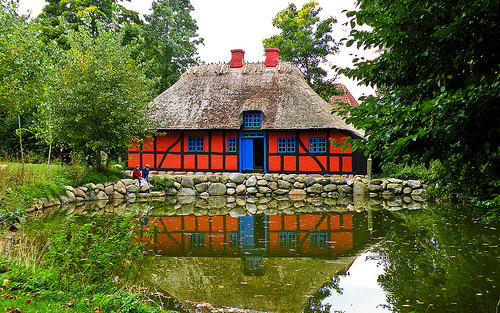

Location: Lyngby Map
Tel. 33 13 44 11
Open: Apr- Oct 10am- 5pm Tue- Sun
Frilandsmuseet is an open air museum situated in the Lyngby on the northern outskirts of Danish capital of Copenhagen. Frilandsmuseet covers an area of over 40 hectares. Over 100 buildings from different social strata were brought here from various villages of Denmark and date back to the 17th century. The museum admission is free of charge. You can get here from Copenhagen using a number 184 or 194 bus from Nørreport Station or by S train to Sorgenfri station. Many volunteers including blacksmiths, bricklayers, carpenters and many others come to Frilandsmuseet and show traditional Danish crafts that were common in the rural area.
In 1896, the founder and leader of the
Danish Folk Museum, Bernhard Olsen, purchased a farm from Halland
and an attic shed from Småland, which was set up in a corner of
Kongens Have. The plan to create a building museum on this site
failed, so they started looking for a new site, and on June 24,
1901, the Open Air Museum was opened at its current address at
Fuglevad Windmill.
Since then, a large number of buildings
have been added.
The museum contains rural buildings from different parts of Denmark, the Faroe Islands and the former Danish counties Skåne, Halland and South Schleswig (in addition to the Småland buildings, which were supposed to illustrate various lost building types). The buildings are furnished as they were when they were inhabited by farmers, agricultural craftsmen or the people of the estate and show the daily life of the Danes throughout history with alcoves, tools, clogs and decorative objects. It gives a nuanced picture of the Danes' everyday life in the period 1650-1940. Animals of old, Danish breeds graze on the fields: lambs, kid goats, geese, ducks, horses and cows.
The museum has 25 historical gardens with flowers,
fruit trees and useful plants that show the customs and usage of
different times.
In the classic farmhouse, the beautiful and the
useful are united. The garden's plants and flowers were used for dyeing,
medicine or seasoning, and the garden was divided into several sections,
each with its own function: orchard, cabbage garden, herb garden and
firewood garden.
In the romantic farm garden, there were green
gazebos made of linden or beech, and the fruit trees stood in the lawn
of the ornamental garden, while the beds were used for potatoes or
vegetables instead of flowers.
The manor's park originates from the
Klunky era with its love for the cluttered and exotic. The garden
contains a park-like ornamental garden with exotic flowers and trees and
a large kitchen garden with vegetables, flowers and fruit for both lords
and servants.
The museum is recreating a station town from the
childhood of industrialization, which shows a machine shop, a
blacksmith's workshop and a station. Brugsen sells goods of the time
with everything from spirits, sewing accessories, toys, hardware and
trinkets to colonial goods and coarser agricultural goods.
During
special periods, several of the houses are inhabited by employees who
communicate via living history. This mainly takes place during the
school summer holidays.
Among the museum's buildings are three windmills. An
older mill is a stub mill from Karlstrup (Karlstrup Mølle), built around
1662, renewed in 1763 and moved to the Frilandsmuseet in 1921. The mill
has two "floors" and can be turned by one man, who pulls the "back
step". The stump mill can be seen from Kongevejen. The mill can run, and
it is possible to get up to it on certain days.
A newer mill is
the Fuglevad windmill – a Dutch gallery built on the site in 1832. The
third is a small windmill in connection with a farm from Læsø.
The open-air museum also has several water mills: an underfall mill with
half-timbering from Pedersker on Bornholm, a swash mill from Sandø on
the Faroe Islands and one from Småland and finally the Møllergården from
Ellested on Funen. The mills are looked after by the Frilandsmuseet's
Miller Guild.
During the season there are, among other things,
theater performances, garden trips, old games and sales from the utility
in the station town. In the summer and autumn of 2018, the new
initiative "Frøsnapperfestival" was launched in the museum's station
town, which temporarily changed its name to "Frøsnapperbyen" for the
occasion. It was such a great success in terms of audiences that it was
repeated in the summer of 2019 and supplemented by yet another new
festival called "Bonderøvsfestival". In the autumn holidays 2019, the
museum also organized a "Halloween festival" as a replacement for the
previous autumn markets".